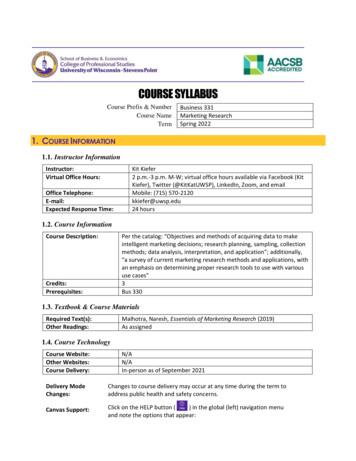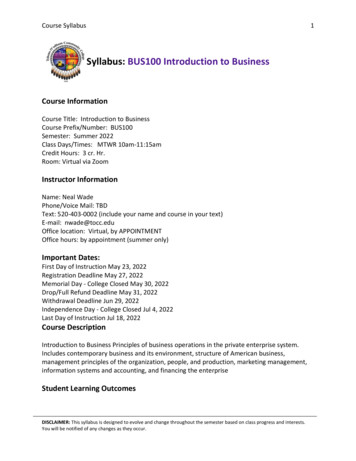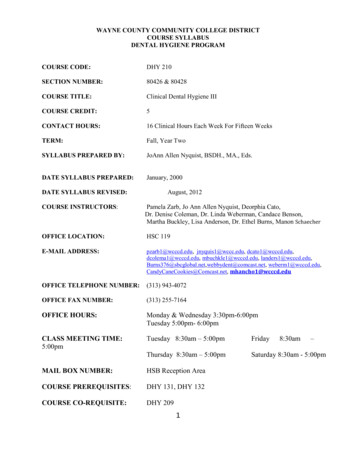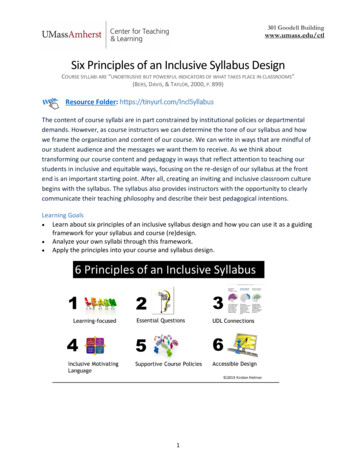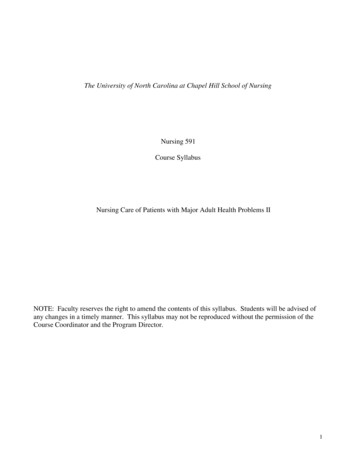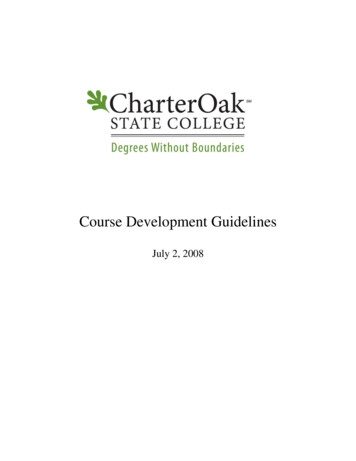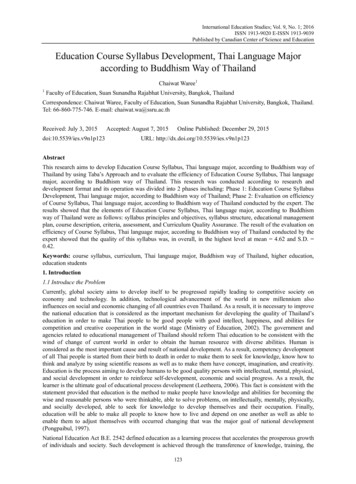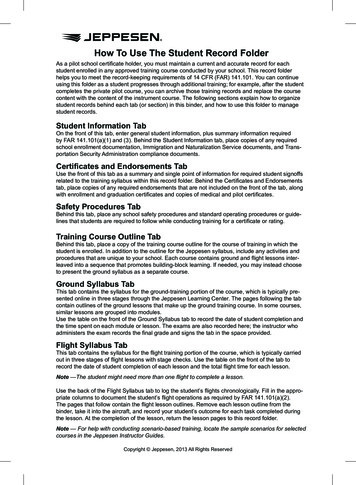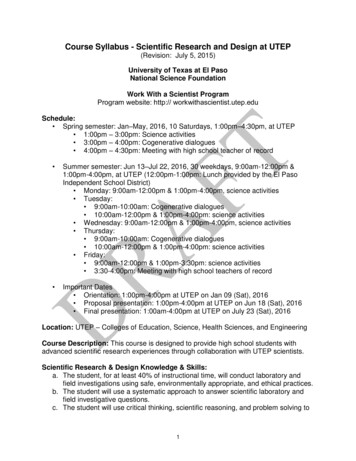
Transcription
Course Syllabus - Scientific Research and Design at UTEP(Revision: July 5, 2015)University of Texas at El PasoNational Science FoundationWork With a Scientist ProgramProgram website: http:// workwithascientist.utep.eduSchedule: Spring semester: Jan–May, 2016, 10 Saturdays, 1:00pm–4:30pm, at UTEP 1:00pm – 3:00pm: Science activities 3:00pm – 4:00pm: Cogenerative dialogues 4:00pm – 4:30pm: Meeting with high school teacher of record Summer semester: Jun 13–Jul 22, 2016, 30 weekdays, 9:00am-12:00pm &1:00pm-4:00pm, at UTEP (12:00pm-1:00pm: Lunch provided by the El PasoIndependent School District) Monday: 9:00am-12:00pm & 1:00pm-4:00pm, science activities Tuesday: 9:00am-10:00am: Cogenerative dialogues 10:00am-12:00pm & 1:00pm-4:00pm: science activities Wednesday: 9:00am-12:00pm & 1:00pm-4:00pm, science activities Thursday: 9:00am-10:00am: Cogenerative dialogues 10:00am-12:00pm & 1:00pm-4:00pm: science activities Friday: 9:00am-12:00pm & 1:00pm-3:30pm: science activities 3:30-4:00pm: Meeting with high school teachers of record Important Dates Orientation: 1:00pm-4:00pm at UTEP on Jan 09 (Sat), 2016 Proposal presentation: 1:00pm-4:00pm at UTEP on Jun 18 (Sat), 2016 Final presentation: 1:00am-4:00pm at UTEP on July 23 (Sat), 2016Location: UTEP – Colleges of Education, Science, Health Sciences, and EngineeringCourse Description: This course is designed to provide high school students withadvanced scientific research experiences through collaboration with UTEP scientists.Scientific Research & Design Knowledge & Skills:a. The student, for at least 40% of instructional time, will conduct laboratory andfield investigations using safe, environmentally appropriate, and ethical practices.b. The student will use a systematic approach to answer scientific laboratory andfield investigative questions.c. The student will use critical thinking, scientific reasoning, and problem solving to1
d.e.f.g.h.make informed decisions inside and outside the classroom.The student will formulate hypotheses to guide experimentation and datacollection.The student will analyze published research.The student will develop and implements investigative designs.The student will collect, organize, and evaluate qualitative and quantitative dataobtained through experimentation.The student will learn how to synthesize valid conclusions from qualitative andquantitative data.Student Learning Outcomes:a. Obtain contextualized knowledge about ongoing scientific projects at UTEP.b. Improve scientific thinking skills.c. Develop research skills.d. Develop teamwork skills.e. Develop professional communication skills.f. Maintain safe laboratory work habits.Instructors and Assistants:1. UTEP faculty (scientists) Instruct students and guide them in their research projects Engage in cogenerative dialogues with students to improve scientific practice Assist high school students with the generation of: (a) a “Research Proposal”and a corresponding poster that includes students’ own research questionand research plan that has scholarly value and significance for the sciencecommunity, (b) a “Project Plan” that will be implemented in summer time, and(c) a “Project Report” and a corresponding poster that students will present atUTEP-open house events Inform the program director, Dr. Pei-Ling Hsu, and the teachers of record ofany scheduling changes to accommodate science activities (e.g., field trips)one week before the change is to take place and ensure that students havetransportation arranged.2. Science research assistants (Science RA) Assist UTEP faculty to provide guidance and lab resources to allow studentsto conduct their own research projects Engage in cogenerative dialogues with students to improve scientific practice Assist high school students with the generation of: (a) a “Research Proposal”and a corresponding poster that includes students’ own research questionand research plan that has scholarly value and significance for the sciencecommunity, (b) a “Project Plan” that will be implemented in summer time, and(c) a “Project Report” and a corresponding poster that students will present atUTEP-open house events3. Education research assistants (Education RA) Mediate cogenerative dialogues with scientists and students to improvescientific practice Assist scientists and science assistants in implementing activities2
Remind students of deadlines and of scheduled activities and assignmentsVideo record, collect field notes, and take pictures of students throughout anyactivities related and relevant to the project Provide Excused Absence Request form (also available in the syllabus and atproject website) to students upon request and will submit the signed form tothe program director for approval Provide make-up session form (also available in the syllabus and at projectwebsite) upon request4. High school teachers of record Accompany students throughout the program and take attendance Follow up on student absences with their parents and provide make-up worksessions within one week of absences Remind students of assignment deadlines, grade student assignments online,and follow up with students for missing assignmentsReadings* Harland, D. (2011). STEM student research handbook. Arlington, VA: NSTA Press. Ch1: Beginning a STEM Research Project Ch2: Research Design Ch3: Background Research and Note Taking Ch4: Writing Hypotheses Ch5: Proposal Writing Ch6: Organizing a Laboratory Notebook Ch7: Descriptive Statistics Ch8: Graphical Representations Ch9: Inferential Statistics and Data Interpretation Ch10: Documentation and Research Paper SetupAssignments:1. Individual Work (60 points)(1)15 journal submissions (45 points; each entry is 3 points; Template 1,Rubric 1)(2)Reflection on proposal presentation (3 points, Template 3)(3)Reflection on final presentation (3 points, Template 6)(5)Attendance (9 points): Attendance is critical to receive the full benefits ofthe unique course at UTEP. Attendance awards will be given at the end ofMay and July to acknowledge students’ commitment. Each absence willresult in one point reduction. If the make up session is not completed,another point will be deducted from the total attendance points. That is, astudent will have two points reduction if s/he does not complete a make upsession when s/he has an absence.2. Group Work (40 points)(1)Research proposal (10 points; Template 2)(2)Proposal presentation poster (5 points; Rubric 2)3
(3)(4)(5)Project plan (10 points; Template 4)Final research report (10 points; Template 5)Project presentation poster (5 points; Rubric 2)* The due dates and submission times for each assignment can be found in Table 1and Table 2.Course Requirements:1. All assignments (individual and group work) should be submitted through theBlackboard system using Word files. File names should start with your name orgroup name and end with the assignment name. For example, take the groupname of “Lab1-Group1” and name of “Isaac Newton.” IsaacNewton-Journal1.doc IsaacNewton-Journal2.doc Lab1-Group1-ResearchProposal.doc Lab1-Group1-ProposalPresentationPoster.doc2. Students will be provided with a laptop, issued by El Paso Independent SchoolDistrict, to record their notes and submit their assignments to the CourseSitesystem (https://peilinghsu.coursesites.com/). Students can also access templatesfor journals and for group assignments on CourseSite.3. Due dates for each assignment are listed in Table 1, 2, and 3. The due time forelectronic submissions is 8:00pm (individual and group work). Delayedsubmissions of any assignments will cause grade reductions. One late daycauses a 10% reduction of a deserved grade, two late days causes a 20%reduction of a deserved grade, and so on. Grading evaluations: A (90–100points), B (80–89 points), C (70–79 points), D (60–69 points), F ( 60 points).4. Students cannot be absent for more than three days. Students who have morethan three unexcused absences will be dropped from the course/project. If thestudent wants to apply for an excused absence, he/she must fill out an ExcusedAbsence Request form (available at students’ syllabus [Appendix 1], projectwebsite, and from Education RA), get it signed by their scientist, their teacher ofrecord, their parents/guardians and the program director one week before theabsence date. To obtain the signature of the program director, students need tosubmit the form to their Education RA after they have obtained the signaturesfrom their scientist, parents/guardians and teacher of record; the Education RAwill give the form to the program director for approval. If the request is approvedby the program director, a scanned copy of the approval will be emailed to thestudent, the scientist, and the teacher of record. In the event of an emergency orsudden illness, the student or his/her parent or guardian must call the teacher ofrecord no later than 12:00pm each day the student is absent.5. Students who are absent must ask for a make-up session with the teacher ofrecord upon the students’ return to school within one week. A Make-Up Sessionform (available at students’ syllabus [Appendix 2], project website, and from4
Education RA) needs to be completed within one week of the absence.6. This course is a unique course that requires students to participate on weekendsand in the summer. Thus, parent/guardian agreement and support are required.The student’s parent/guardian will be asked to sign a parent agreement / supportdocument before students are admitted to the course.7. This course is funded and supported by a UTEP research project. Students’participation will include collaboration with researchers at UTEP (e.g., studentswill be video-recorded and photographed for program activities, will be requiredto complete research surveys, and will be interviewed about theirparticipation/perception). Project website: http:// workwithascientist.utep.edu8. 450 financial support: A student will be supported with 450 when s/hecompletes the project. The 450 will be distributed proportionally throughout theproject (i.e., 100 by the end of May, 100 by the end of June, 100 by the endof July, and 150 six months after the program graduation when a studentcompletes the follow-up interviews/surveys).9. Students will be randomly assigned to scientists from different fields of study.10. Students’ transportation will be provided by El Paso Independent School Districtfrom schools to UTEP and back at no cost. Students should arrive on time toprevent delaying the bus schedule. If students are going to arrive late, please callteacher of record immediately. There is no guarantee that the bus will wait forstudents and students may have to find alternate transportation if students missthe bus.*Please note that every effort will be made to adhere to the syllabus. However, theschedule may be changed due to emergent events/issues.5
Table 1. Spring semester activity and assignment schedule.MonthJanDate09, Sat, 1:00–4:30pm23, Sat, 1:00–4:30pmActivityOrientation at UTEPSafety training and introduction to cogenerativedialogueFebSame above (Learn “Scientific Thinking”)19, Sat, 1:00–4:30pmSame above (Learn “Scientific Thinking”)Same above (Learn “Scientific Thinking”)16, Sat, 1:00–4:30pmSame above (Learn “Scientific Thinking”)Same above (Learn “Scientific Thinking”)Same above (Learn “Scientific Thinking”)Ch6Journal 8(Template 1)Same above (Learn “Scientific Thinking”)Ch7Journal 9(Template 1)May 16, Mon, by 8:00pm28, Sat, 1:00-4:00pmCh3–5Journal 7(Template 1)02, Mon, by 8:00pm14, Sat, 1:00–4:30pmCh5Journal 6(Template 1)18, Mon, by 5:00pm30, Sat, 1:00–4:30pmCh4Journal 5(Template 1)04, Mon, by 8:00pmAprCh3Journal 4(Template 1)21, Mon, by 8:00pm02, Sat, 1:00–4:30pmCh1–2Journal 3(Template 1)07, Mon, by 8:00pmMarCh2Journal 2(Template 1)22, Mon, by 8:00pm05, Sat, 1:00–4:30pmCh1Work with UTEP scientists to learn scientificthinking (e.g., how to frame a research question,design experiments, and find solutions)8, Mon, by 8:00pm20, Sat, 1:00–4:30pmReadingJournal 1(Template 1)25, Mon, by 8:00pm6, Sat, 1:00–4:30pmAssignmentSame above (Learn “Scientific Thinking”)Ch8Journal 10(Template 1)30, Mon, by 8:00pm6
Table 2. Summer activity and assignment schedule (Lunch will be provided by EPISD to eat at UTEP).Month WeekDateActivityAssignmentReadingJune 13 to Students are assisted by scientists to conduct their experiments, write their proposals &July 22plans, and develop their poster presentation to be presented on July 23, 2016Work with UTEP scientists toGroup work 1: “ResearchCh9prepare Research Proposal and Proposal” (Template 2)Proposal Poster. Submit a paper By 8:00pm, June 16, upload13–17, Mon–Fri,copy of Research Proposal with proposal to CourseSites.9:00am–4:00pmyour scientist’s signature to your By 3:00pm June 17, submitEducation RA by 3:00pm onprinted & signed proposal toJune 19.your Education RA317, Fri, by 8:00pmJournal 11 (Template 1)Proposal presentations (parents18, Sat,Group Work 2: Proposal Poster,are invited) * Evaluation criteria1:00–4:00pmsubmit to your Education RA(Rubric 2)JuneProposal Presentation19, Sun, by 8:00pmReflection (Template 3)Group Work 3: “Project Plan”Ch10Work with UTEP scientists to(Template 4)prepare Project Plan. Submit aBy 8:00pm, June 23, upload20–24, Mon–Fri,paper copy of Project Plan withProject Plan to CourseSites.your scientists’ signatures to4 9:00am–4:00pmBy 3:00pm June 24, submityour Education RA by 3:00pm onprinted & signed Project Plan toJune 26.your Education RA25, Sat, by 8:00pmJournal 12 (Template 1)June 27 -July 01,Ch6–10Mon–Fri, 9:00am– Hands-on scientific practice14:00pm02, Sat, by 8:00pmJournal 13 (Template 1)05–08, Tue–Fri,Same above (“Hands-onscientific practice”)2 9:00am–4:00pm09, Sat, by 8:00pmJournal 14 (Template 1)11–15, Mon–Fri,Same above (“Hands-on9:00am–4:00pmscientific practice”)Group Work 4: “Final Research315, Fri, by 8:00pmReport” (Template 5), uploadJulyproposal to CourseSites16, Sat, by 8:00pmJournal 15 (Template 1)18–22, Mon–Prepare “ResearchFri,9:00am–4:00pm Report/Presentation”Group Work 5: Final Research22, Fri, by 8:00pmPoster, upload proposal to4CourseSitesFinal research presentations at23, Sat, 1:00pm–UTEP (parents are invited)4:00pm* Evaluation criteria (Rubric 2)Reflection on final presentation5 25, Mon, by 8:00pm(Template 6)One post interview with a researcher (time and placeAug1will be arranged with individual students)Table 3. Follow up interview in 2017.Mar–May in 2017One follow-up interview with a researcher (specific time and place will be arrangedwith individual students)7
Template 1: “Journaling”Journal 1(Please update the journal number accordingly, e.g., Journal 2, Journal 3, etc.)1. What did you learn about the scientific practice (e.g., data, equipment, concepts) thisweek? (minimum: 120 words)2. How was your learning experience this week? (minimum: 120 words)3. How was your experience in cogenerative dialogues this week? (minimum: 120words)4. What was the most interesting observation this week? (minimum: 120 words)8
Template 2: “Research Proposal”Research Proposal (minimum: 1,000 words)The Research Proposal will include students’ own research question and researchplan that have scholarly values and significances for the science community.Scientists will assist students to brainstorm students’ own innovative researchquestion (i.e., the proposed experiment was not conducted in this lab before) and willNOT generate research questions for students.Part A: IntroductionA-1. Group members:A-2. Leading scientist in the lab:A-3. Other mentors:A-4. Project title:A-5. Research question:Part B: Research significanceB-1. Research significance:Part C: Experiment design:C-1. Equipment and tools required for this experimentC-2. Methods for this experimentC-3. Type of data that will be obtainedC-4. Timeline for implementing the experimentPart D: Expert confirmation of innovation:D-1. As a leading scientist in this lab, I, (print), confirm thatthis proposed experiment has not been conducted in this lab before.Signature: Date:9
Template 3: Reflection on proposal presentationReflection on the proposal presentation1. What did the proposal presentation mean to you? (minimum: 120 words)2. What was your experience of the proposal presentation? (minimum: 120 words)3. What did you learn from the proposal presentation? (minimum: 120 words)4. What aspects of the proposal presentation would you do differently if you were topresent again? (minimum: 120 words)10
Template 4: “Project Plan”Project Plan (minimum: 1,000 words)Part A: IntroductionA-1. Group members:A-2. Leading scientist in the lab:A-3. Other mentors:A-4. Project title:A-5. Research question:Part B: Research significanceB-1. Research significance:Part C: Experiment design:C-1. Equipment and tools required for this experimentC-2. Methods for this experimentC-3. Type of data that will be obtainedC-4. Timeline for implementing the experimentPart D: Two experts’ confirmation of scholarly value:D-1. As a leading scientist in this lab, I, (print), confirm thatthis project plan has scholarly value for the science community.Signature: Date:D-2. As a scientist working in a relevant field, I, (print),confirm that this project plan has scholarly value for the science community.Signature: Date:11
Template 5: “Final Research Report”Final Research Report (minimum: 2,000 words)Part A: IntroductionA-1. Group members:A-2. Leading scientist in the lab:A-3. Other mentors:A-4. Project title:A-5. Research question:Part B: Research significanceB-1. Research significance:Part C: Experiment designC-1. Equipment and tools required for this experimentC-2. Methods for this experimentC-3. Type of data that will be obtainedC-4. Timeline for implementing the experimentPart D. Research findings12
Template 6: Reflection on final presentationReflection on final presentation1. What did the final presentation mean to you? (minimum: 120 words)2. What was your experience of the final presentation? (minimum: 120 words)3. What did you learn from the final presentation? (minimum: 120 words)4. What aspects of the final presentation would you do differently if you were to presentagain? (minimum: 120 words)13
Appendix 1. Excused Absence Request FormStudents who have more than three unexcused absences will be dropped from the course/project. If thestudent wants to apply for an excused absence, he/she must fill out this Excused Absence Request form,get it signed by their parent/guardian, scientist, their teacher of record, and the program director oneweek before the absence date. To obtain the signature of the program director, students need to submitthe form to their Education RA after they have obtained the signatures from their scientist,parent/guardian and teacher of record. The Education RA will give the form to the program director forapproval. If the request is approved by the program director, a scanned copy of the approval will beemailed to the student, the scientist, and the teacher of record.Student Name:Student ID:Date of Absence:Lab:1. What is the reason for your absence?2. Why is this event important to you?3. What efforts did you make to try to accommodate your schedule?Parent/Guardian Name:Parent/Guardian Signature: Date:Scientist (UTEP faculty) Name:Scientist Signature: Date:Teacher of Record Name:Teacher of Record Signature: Date:Program Director Name:Program Director Signature: Date:14
Appendix 2. Make Up Session FormName: ID:UTEP Scientists/Lab:Names of my other two group members:Date of my absence:Reason of my absence:Make Up Session ChecklistEach absence will result in one point reduction. If the make up session is not completed, another point willbe deducted from the total attendance points. That is, two points reduction if you do not complete a makeup session when you have an absence.I asked my two group members to help me catch up activities during my absence.I asked my scientist (UTEP faculty) to help me catch up activities during my absence.I asked the teacher of record to help me catch up activities during my absence.Signatures from two group members:1. My name is . I communicated the activities to mygroup member who was absent that day and help him/her to catch up the work.Signature: Date:2. My name is . I communicated the activities to mygroup member who was absent that day and help him/her to catch up the work.Signature: Date:Signature from UTEP scientist (faculty):My name is . I acknowledge that the studentcommunicated with me and caught up work during his/her absence.Signature: Date:Signature from the teacher of Record:My name is . I acknowledge that the student caughtup work occurred during his/her absence.Signature: Date:15
Rubric 1: Criteria for Evaluating JournalsDimensionsQuality of writingUnderstanding ofthe steps andskills of thescientific methodand inquiryUse of diagramsand illustrationsto communicateideasUnderstanding ofinformationExtended thinkingNeeds More EffortSatisfactoryOutstanding Organization orneatness needsattention Ideas are somewhatorganized and neat Organized, neat, wellthought ideas Scientific vocabularyUses little scientificvocabularyOccasional use ofscientific vocabulary Notes/explanationsnot totally completeDetailed, descriptive,completenotes/explanations Notes/explanationsare incomplete Some steps of labidentified correctly Most steps of labsidentified correctly All steps of labsidentified correctly Explanations are notaccurate/clear Mostly accurateexplanations Accurate explanations Not totally accurate Accurate and complete Missing quite a fewlabelsAccurate but notcomplete All labels Some labels Neat Not neat Neat Explanations notaccurate or missinginformationQuestions not relativeor showing muchthought Mostly accurateexplanations Accurate scientificexplanations Questions apply butdo not show muchcreativity Able to generateunique questions thatrelate Not many examples ofcreative, individualthinking Did not meet all theminimumrequirements of thelessonHas some creativeexamples ofindividual work andideas Did the minimumrequirements foreach lessonHas many examples ofindividual and creativeways of thinking aboutinformation (i.e., uniquequestions, illustrations,observations, problemsolving descriptions,ideas for projects orexperiments, etc.) 16
Rubric 2: Criteria for Evaluating Proposal Presentation and Final Report PresentationPresentation #: PRESENTER'S NAME (first & last): JUDGE'S NAME:For each of the criteria listed on the left, please rank the content and presentation by circling the appropriate cell (excellent, very good, satisfactory, needsimprovement).CONTENTIntroduction &ObjectiveMethodsResults ELLENTVERY GOODSATISFACTORYNEEDS IMPROVEMENT There is an appropriate amount ofbackground information provided. Connections made to literature. Objective clearly stated and related tobackground. Thorough explanation of methods usedand how they relate to objective. Method was original, innovative, and/orvery well designed. A substantial amount of high qualitydata was presented to address theirobjective. The conclusions are clear and stronglysupported with evidence. There was a clear indication ofimplications and future researchdirections. Likely contributing to publishable work. There is some background information thathelps to understand the study. Objective presented. No background information isprovided. Good explanation of methods used. Methods clearly relate to objective. There is some backgroundinformation but it is not adequate tounderstand the study. Objective unclear and/or notrelated to background information. Methods used are unclear and/ornot appropriate for the study. The data presented mostly address theobjective. The conclusions are mostly supported bythe data. The data presented do notadequately address the objective. The conclusions are only partiallysupported by the data. There was some indication of futureresearch directions and implications of work. Some attempt was made torecommend future researchdirections and/or implications ofresearch were presented. Logical flow from introduction tomethods, results, conclusions. No unnecessary information. There is some difficulty indetermining the flow of the story. Some unnecessary informationon the poster.There are 1 or 2 of these problemson the poster:1. Distracting colors or features2. Too much text3. The text is too small4. Unreferenced figures/tables5. Errors (spelling, grammar, etc.) Layout is not logical and it isdifficult to follow the story. Too much unnecessaryinformation on the poster.There are 3 or more of theseproblems on the poster:1. Distracting colors or features2. Too much text3. The text is too small4. Unreferenced figures/tables5. Errors (spelling, grammar, etc.) Language and mannerisms aremostly appropriate. Talk is too brief or not concise ornot well prepared. Audience has some troublefollowing the talk. Presenter can only answer simplequestions. The presenter mumbles, usesincorrect grammar, has distractingmannerisms, and/or uses jargonexcessively. Audience has trouble followingthe talk. Presenter cannot answer simplequestions.Visual Aids Colors and contrast simple andeffective. Perfect font size (i.e., readable from 6feet, excluding captions). Appropriate amount of text. Figures referred to in text. No errors. Logical flow from introduction to methods,results, conclusions. Very little unnecessary information on theposter. Colors and contrast good. Adequate font size (i.e., readable from 4feet, excluding captions) Appropriate amount of text. Figures referred to in text. Only 1 or 2 minor errors (spelling, grammar,figure numbering, etc.).OralPresentation Presentation is clear, articulate, andconcise. Audience can easily understand andfollow the talk. Presenter easily answers questions andcan think critically on the spot. Presentation is clear and concise. Audience understands and follows the talk. No distracting mannerisms are observed. Presenter easily answers questions butcannot address issues not directly presentedon the poster.*****Please write any comments on the reverse**** Little to no explanation ofmethods used. Methods do not relate toobjective. The data presented do notaddress the objective. The conclusions are notsupported by the data and/or areunrelated to the hypothesis. No future research directions orimplications of research werepresented.(These evaluation criteria were adapted from Chemistry Department resources UTEP17
Final presentation: 1:00am-4:00pm at UTEP on July 23 (Sat), 2016 Location: UTEP - Colleges of Education, Science, Health Sciences, and Engineering Course Description: This course is designed to provide high school students with advanced scientific research experiences through collaboration with UTEP scientists.




